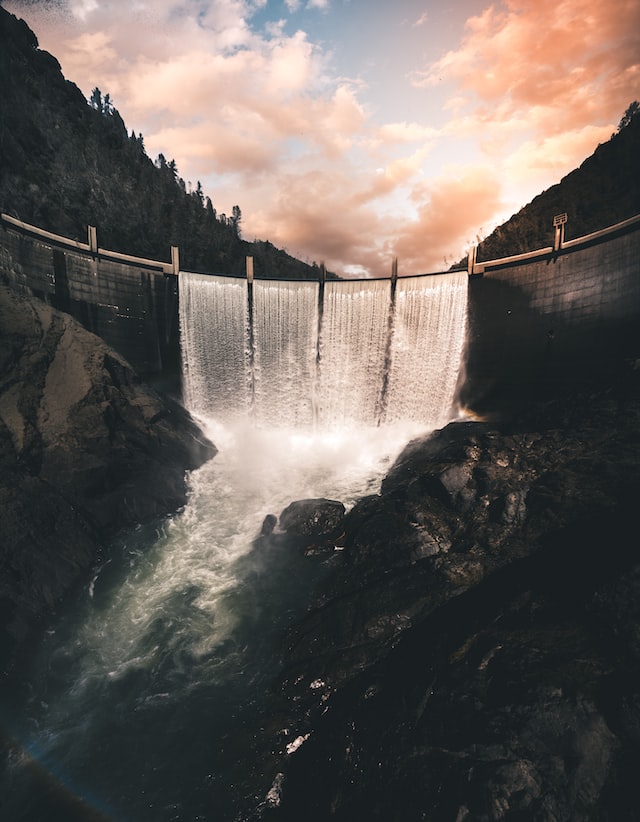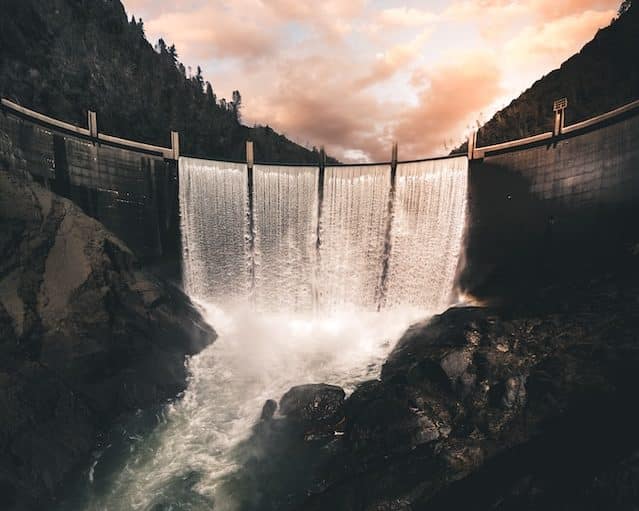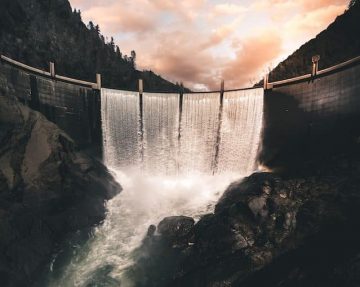Guest post by Catherine S, who lives in Utah with her husband, three kids, and puppy. Among her list of personal doctrines are to dance to music that moves you, indulge in curiosity and creativity, and love your neighbor; love your family; love yourself; love the earth; love life in and around you.
Some people describe a faith crisis as their “shelf breaking.”
When you encounter problematic history, doctrine, etc, you put it on a shelf. Up high where it’ll gather dust. For some, that becomes a multivolume encyclopedia. A weight that wasn’t meant for a “15-pound max” piece of cheap plywood your bishop hurriedly counseled you to put up when you first learned that Joseph Smith did WHAT?!

The Dam
For me, the shelf felt more like a dam. Existing to impede and control the information and feelings meant to flow through us; to nourish, inform, challenge and confuse us; to tickle our toes and cool our brow. But free-flowing information can’t be censored. And sometimes it contradicts the Truth. So, as soon as I ran into “issues” I started to build. One brick at a time. But the more I tried to stop the flow, the heavier the weight. Eventually, I had built a dam fortress and lived in denial of the mass of water rising on the other side.
Dams come in many shapes and sizes. Many builders are proud of the strength of their creations. Many dams stand today, strong and unyielding. My parents both have dams that simplify the way they see the world. The dams turn things into black or white and then keep out all the darkness. They serve their purpose by keeping the plain and simple beliefs untouched. I can’t argue the beauty in that.
But my dam was doomed.
Small leaks started breaking through years ago. Then, the deconstruction process began one brick at a time. This went on for a while. Things got precarious. Finally, my dam began to crumble.
Like my parents, my husband built a dam over the course of his adult life. It was always a little unsteady as he saw the goodness it was holding back. For him, the dam was blown to pieces in about two weeks. He’s still busy with a sledgehammer, breaking up the pieces.
Ours were doomed dams.
Whether a crumble or an explosion, deconstruction leaves a lot of debris. Maybe you’ve been there. The water isn’t clear and beautiful, it’s full of muck and rubble. You might even feel like you’re being pulled under, trying to figure out which way is up. The St. Francis Dam of Los Angeles, CA failed in 1928. It is considered one of the worst civil engineering disasters of modern time. The 120 ft flood wave that resulted swept away buildings and powerlines, tore up the landscape and killed over 400 people. What was left was unrecognizable.
The same can be true after your dam breaks. The timeline of your life is now speckled with question marks, things you were sure of are now looming uncertainties. The easy answers that you fought so hard against to break down your dam now bring a sense of nostalgia; you see the beauty of their simplicity now that they’re gone. What’s your purpose? Your priorities? Your beliefs? Your identity? The questions hit over and over again, unrelenting now that they’re not confined behind the dam of certainty and Truth.
The fortress you built your life next to was comforting. Secure. Once it’s gone, things can feel… empty. Agoraphobic. You may be desperate to rebuild, to have something to replace all of the certainty and neatness of your world before the dam deconstruction.
Feel
For me, the first step to rebuilding was not to build. Instead, I simply existed among the rubble—the beliefs and ideas that I’d assumed were True, unquestionable. Joseph, Brigham, prophets, literal scripture, commandments, promised blessings, priesthood, temples, revelation, God. They all felt so interdependent that for a time, they all had to go. New experiences and ideas, unfiltered, washed them downstream little by little. I watched as one piece after another slowly drifted further away. I felt the pain of betrayal, control, and indifference. I let it saturate me. It infuriated me. It broke my heart. And, there was a sense of relief. I let myself feel that too.
Before the dam demolition, I had a processing system that worked pretty well. It was the instruction manual of the dam. Here’s how to keep out the stuff you shouldn’t be thinking or feeling: Ignore it. Look at the “big picture” (minimize?). Replace it with something that makes you feel safe. I checked new information or feelings against the archives of the dam I had built and shoved it hard enough that it would fit into spaces it didn’t belong in.
It was a totally new experience for me to feel feelings without self-judgment or self-censorship. I had worked so hard building my dam, I didn’t realize that I wasn’t just holding back information, I was holding back my own feelings and keeping myself from trusting my experiences.
Now, like the refreshing trickle of a stream’s fresh water, I’m determined to experience, learn and feel with curiosity. I no longer need to feel anxiety or self-judgment about my natural feelings or thoughts. But, noticing that anxiety and judgment when it does come helps me build a new system for processing my thoughts and feelings. My cognitive dissonance is an indicator that I have something to explore—not ignore. Oh! Am I feeling homophobic? Racist? Judgmental? Afraid? Defensive? Entitled? Skeptical? I wonder where that’s coming from? What should I do with it? My emotions around new information are just that: information. I pop open a bag of popcorn and just observe what’s happening in my mind and body. I often, sometimes with excitement, wonder if I’m wrong, something I learned from Think Again by Adam Grant and the Secular Buddhism with Noah Rasheta podcast.
Sometimes a particular piece of dam rubble didn’t seem like it would ever clear out and I wondered if I would always feel sadness, anger, or fear. And then one day, I started to feel embers of something new. Warmth. Hope. Peace. Love. The air had begun to clear and I could see I was missing out on an amazing panorama. My relationships were more sincere, I loved myself more deeply, and I no longer saw “the world” and its philosophies with suspicion but as my home and my family—full of quirks and mystery, beauty, and crudeness.
The water behind my dam was starting to clear and it was magical and exciting; like nothing I had dared let myself explore or taste behind my dam. Feeling during my faith crisis was the foundation for moving forward. I wanted more.
Expand
I gave myself permission to open my mind and my heart to the world and all of her people, ideas, passions and pain. I let down my guard to allow for expansion; Michael Wilcox describes this in his Faith Matters podcast episode “God’s Many Voices.” This freedom has made me ravenous for new, beautiful, terrifying, exciting ideas.
Even the stories that I’d heard all my life suddenly took on new meaning and beauty. Two books I read during my deconstruction, Evolution of God by Robert Wright and The Bible Unearthed by Israel Finkelstein and Neil Asher Silberman, deconstructed many of the stories I had told myself about the Bible, but they both ended with a new and beautiful way of looking at the stories told: not as lies, but as human. Some of my more recent reads have done the same, on a more personal level including Learning to Walk in the Dark by Barbara Brown Taylor and Unorthodox by Deborah Feldman. Taylor explores the darkness that my parents’ dams filter out and discovers the beauty and necessity it holds for her and humanity. Feldman uncovers a trauma that I haven’t experienced but can sense around me and paves new paths that I want to follow. These are human stories about people looking for meaning, community and God. Just like me. These are the ideas I’ve let myself soak up and hold onto as other things wash on.
As I continue to push myself to expand, I find myself coming full circle, discovering pieces of my dam rubble, strewn across the river. And with trepidation, I pick some of them up. It took time for me to consider repurposing some of the pieces of my dam to rebuild. That’s not for everyone but I think it might be for me.
I want to build. And right now, that’s all I’ve got. Nothing to show for my efforts yet, just desire. I’m hoping that nurturing that desire will yield a beautiful construction. Perhaps my dam was doomed. But not just to crumble. It was doomed to be confined to its own chapter, laying the groundwork for new construction.
I want to rebuild with ideas and experiences, new and old. But this time, instead of building a dam with the intent to keep things controlled or contained, I want to build bridges to connect; towers to expand my horizons; and perhaps a personal sanctuary where I can feel the cool stream flow by me.
***
This post is part of the series, Reconstructing Faith. Find more from this series here.







6 Responses
I relate to so much of this. Thank you for sharing!
“For me, the shelf felt more like a dam. Existing to impede and control the information and feelings meant to flow through us; to nourish, inform, challenge and confuse us; to tickle our toes and cool our brow.” I love this imagery of ideas and doubts and questions and hopes needing to run through us, teach us, and “nourish” us. Also, I love your Buddhist vibes. Thanks for sharing. Good luck on your journey.
The imagery and metaphor of a dam breaking is beautiful and so relatable. I loved the end of your desire to build and form bridges. Same, same. Sending love to you.
I also need to check out those books. This reminds me a lot of the idea of “embodiment” after a “dam” breaks, an idea talked about on the We Can Do Hard Things podcast with Caitlin Curtice.
“We do that [Participate in groups that value people connection over people talking in authority over each other] by pointing out the gaps bewtween lived experience and our values and then by hearing folks out and finding ways to do better.”
For me, this “hits home” in terms of parenting. One of my missions in life right now is to set up an environment where my children are exposed to my values and what I find valuable.
With one child, it is “easy” to transfer/foster my values into her value system. She is 6, so she “values” my approval and attention equal to and/or more then what I actually value and share with her. She also likes candy/bribery in general:)
With another child, I need to have a chess board diagram set up of how to “entrap” her into exposure to my values [note – just exposure – I don’t want to presume that I impose my values even if I wanted to]. I am told (loosely) that this is what is expected for a teenager – and that I have years and years of this. I remind myself of what Robert Fulghum put into words, “Don’t worry that children never listen to you; worry that they are always watching you.”
So while I want a “meeting of the verbally-based minds” with her using words to create a sustaining environment and other lofty ideals, sometimes I am able to be “a better, more disciplined actor” when I remind myself who my “audience” is.
Sorry, wrong thread. I am composing a thoughtful reply for this profound essay/article in the future.